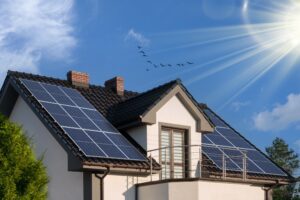Insulating your loft helps reduce energy bills and carbon emissions by preventing heat from escaping through the roof. However, millions of lofts in the UK are uninsulated or have inadequate home insulation, resulting in heat loss and energy bills that are hundreds of pounds a year more expensive.
Research reveals that 50% of homeowners don’t realise that loft insulation is one of the most cost-effective ways to reduce heating costs.
An insulated loft retains three-quarters more heat in your home than an uninsulated loft. In some cases, those benefits can last a lifetime.
You can find out here everything you need to know about loft insulation, including how long it lasts, how much it costs, and how much money it could save you.
Types of Loft Insulation and Their Lifespan
Loft insulation typically lasts around 40 years or much longer, depending on the type of insulation and whether it was appropriate insulation material for the loft space, plus how well it was installed.
Blanket Roll Insulation
Blanket rolls of mineral wool, including rock, or glass wool (fibreglass) are the most common types of loft floor insulation and usually the least expensive.
Mineral Wool Insulation
Mineral wool insulation is made from rock, slag, or glass. There are claims it can last 100 years, but more realistic estimates put the lifespan at 30 to 50 years.
Glass Wool Insulation
Glass wool insulation, consisting of thin, woven fibres of glass, can last 20 to 30 years.
Blown-In Insulation
Blown-in insulation is applied by mechanically blasting mineral fibres or paper- or wood-based cellulose onto surfaces and into gaps. Blown-cellulose insulation has a typical lifespan of 20 to 30 years but may start to degrade after 15 years and need upgrading.
Spray Foam Insulation
Spray foam insulation or polyurethane foam is applied in liquid form that hardens and expands. It’s the costliest type of loft insulation and is not without issues when installed in some situations, so is not installed or recommended by Effective Home.
Foam Insulation Boards
Rigid foam board insulation consists of dense sheets of foam products such as polystyrene or polyurethane. It can last up to 100 years, according to some sources.
When Does Loft Insulation Need Replacing?
Although loft insulation is a long-lasting energy-efficient solution, nothing lasts forever, and you will eventually have to replace insulation. Loft insulation materials start to degrade slowly with time and gradually become less effective in keeping your home warm. Some loft insulation materials also reduce in terms of levels of thermal resistance as they settle over time.
Home insulation experts advise householders to check the condition of their loft insulation every five to seven years. If you’re unsure about the continuing effectiveness of your loft insulation, it may be worth considering getting a professional to take a look and decide if it needs to be replaced.
Aside from how long ago your loft was insulated, other factors may contribute to a loss in efficiency that makes insulation ineffective and requiring replacement.
Installation Faults
If your loft insulation wasn’t installed properly by professionals, you may have problems such as gaps that cause draughts or air leaks. This not only reduces insulation performance but can also cause condensation issues, especially if there isn’t adequate ventilation.
Damp
If loft insulation gets wet, the material won’t do its job properly. This can happen because of lack of ventilation or if rainwater leaks through the roof, which can also result in mould growth that will damage the insulation.
Compression
Loft insulation that’s squashed down won’t perform as well as it should. Insulation material can be compressed by the weight of loft floor boarding, especially if you store multiple items in the loft.
Pest Infestation
Rodents and other household pests like to make their homes in lofts or attics. Mice and rats in particular can damage insulation and reduce its effectiveness by gnawing on the material.
Dust and Airborne Pollutants
Dust particles and pollutants floating about in the air can settle on loft insulation material and negatively impact its effectiveness.
Substandard Insulation Material
Cheap, poor-quality insulation material won’t perform as well as higher-quality materials, and it won’t last as long. Installing loft insulation of such low quality will be a false economy and end up costing you more in the long-term.
Topping Up Loft Insulation
Insulation efficiency is measured in R-Values – level of resistance to heat flow. The thicker the insulation, the higher its R-Value, and the better thermal performance of your loft insulation.
Even if your loft insulation has remained in good condition, it may not have been installed to a sufficient depth, particularly if you live in an older property.
This means energy bills will rise as your heating system compensates for warm air escaping from your living space.
Since 2003, building regulations have stipulated that mineral or glass wool loft insulation should be installed to a minimum depth of 270mm. This compares with 25mm in 1965 and 200mm in 1995.
Adding an extra layer of insulation material on top of existing insulation still in good condition can save an additional £25 a year on heating costs and further reduce your carbon footprint.
Does Your Loft Need More Insulation?
You should be able to tell whether your loft floor needs more insulation by looking across its span. If insulation is covering the joists, you probably have enough, and adding more may not be cost-effective.
On the other hand, if the insulation material sits below the floor joists or is just level with them, you should consider a top-up.
Installing Top-Up Loft Insulation
Extra loft insulation needs to be installed so it’s evenly distributed with no low spots. You may find, for instance, that you need more top-up insulation in the centre of the loft and less along the eaves.
You don’t have to use the same type of top-up insulation as the existing insulation material.
For example, you could put blanket insulation on top of loose-fill insulation, and vice-versa. If you use a blanket roll over loose fill, it needs to be unfaced – with no foil or paper backing.
Loft Insulation Costs
How much you’ll pay to have your loft insulated professionally varies according to considerations such as the size of the loft and amount of insulation needed, and the type of insulation material.
The price may increase if old insulation needs to be removed or access to your loft is difficult.
The cost of insulation materials varies widely from about £5 a square metre for blanket rolls to £90 a square metre for spray-on foam.
Typical costs of loft insulation materials plus installation are around £880 for a mid-terrace house and £930 for a semi-detached house.
Professional loft insulation installation is zero-rated until March 2027, when it’s expected to revert to its reduced rate of five per cent.
Depending on your circumstances and your property, you may be able to access government funding for loft insulation.
How Much Money Does Loft Insulation Save?
Loft insulation can save households up to nearly £370 a year on energy bills, depending on the size of your home.
According to Energy Saving Trust estimates (and based on April 2024 fuel prices), insulating a previously uninstalled loft can reduce annual heating costs by:
- £200 for a mid-terrace house.
- £225 for a semi-detached house.
- £360 for a detached bungalow.
- £370 for a detached house.
Benefits of Loft Insulation
Professionally installed loft insulation will pay for itself many times over during its lifespan. It significantly reduces heating bills and, according to energy efficiency experts at the Energy Saving Trust, can increase property value by 14%.
Not only does loft insulation keep your home warm in winter while lowering energy costs, it also blocks heat from coming into your living space in warmer weather. This maintains your home at a cooler, more comfortable temperature.
Some types of loft insulation, including cellulose and mineral wool, are also known for their ability to reduce noise pollution by absorbing sound.
What Is the Difference Between Cold Loft Insulation and Warm Loft Insulation?
If you’ve been considering loft insulation, you may have come across the terms cold loft and warm loft. When people talk about loft insulation, they’re generally referring to the more common cold loft insulation method.
This entails installing insulation material between and across loft floor timber joists so no heat escapes from the living space beneath.
Warm loft insulation, which is more complex and costlier, is applied between and across the timber rafters of the roof. This allows heat from your living space into the loft. But energy costs will increase as your heating system works harder to keep the rest of your home at a comfortable temperature.
Need to Know More Loft Insulation?
Almost a quarter of UK lofts are uninsulated, losing 25% of the heat the home generates. This could be because many homeowners are in the dark about loft insulation.
Research surveys reveal that:
- 30% of homeowners never venture into their loft and 26%t have no idea what’s in there.
- 30% don’t know how to recognise proper loft insulation.
- 90% are unlikely to consider whether their loft insulation needs improving.
- 42% don’t know what type of loft insulation they have.
- Two-thirds are unaware that the condition of loft insulation should be checked regularly.
- Only 10% review their loft insulation before winter sets in.
If you’re unsure whether your loft is adequately insulated, call Effective Home on 0333 003 0703 or get in touch online to schedule a free, no-obligation loft insulation survey.



